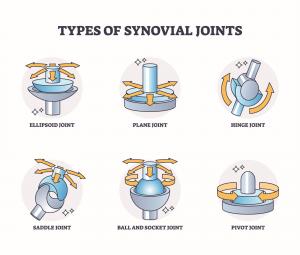The Brookbush Institute Continues to Enhance Anatomy Education with an Update to the Course 'Synovial Joints'
Learn about the 6 synovial joint types: ball-and-socket joint, hinge joint, gliding joint, condyloid joint, pivot joint, and saddle joint.
Additional Study Aids: Gliding Joint2, Condyloid Joint3
SYNOVIAL JOINTS (DEFINITION)
Synovial joints are the most common joint type in the human body. Their unique structure permits more motion than fibrous joints (also known as immovable joints) and cartilaginous joints (partly moveable joints). These unique features include:
- Joint capsule
- Synovial fluid
- Articular cartilage covering bone surfaces
- Articular discs
- Intricate ligament systems to support motion
- Often, they contain bursae.
The synovial joint type, joint shape, joint structure, cartilage, and connective tissue determine how much motion is permitted. Examples of synovial joint types include ball and socket, hinge, pivot, gliding, saddle, and condyloid. Each joint type allows motion in a specific number of planes, and the joint type and available planes of motion correspond to specific joint actions. For example, the elbow joint is a hinge joint, which only allows motion in one plane (sagittal plane), which corresponds to the joint actions of flexion and extension (e.g., biceps curls and triceps extensions). Whereas the shoulder joint is a ball and socket joint, which allows motion in all three planes (sagittal, frontal, and transverse), which correspond with the joint actions of flexion, extension, abduction, adduction, horizontal abduction, horizontal adduction, internal rotation, and external rotation (e.g., horizontal adduction during a bench press). Less commonly mentioned joints include the gliding joints of the carpal bones (wrist bones), the saddle joint of the carpometacarpal joint (thumb), or the pivot joint of the proximal radioulnar joint (forearm). Note the lower limb has the same joint types, including a ball and socket joint (hip joint), hinge joint (knee joint), and gliding joints (transverse tarsal joints).
SYNOVIAL JOINT TYPES BRIEF SUMMARY
- Hinge Joint: A hinge joint (also called a ginglymus joint) is a synovial joint in which the articular surfaces fit one another in a way that is analogous to the hinge of a door. Generally, these joints permit motion in one plane. Examples include the elbow, the knee (unless considered a condyloid joint), and the interphalangeal joints.
- Ball and Socket Joint: A ball and socket joint (also called a spheroid joint or spheroidal joint) is a synovial joint in which the rounded or spherical end of one bone fits into a cup-like depression of another bone. The distal bone is capable of motion around an indefinite number of axes, which have one common center. Examples of ball and socket joints include the hip and shoulder (glenohumeral) joints.
- Pivot Joint: A pivot joint (also called a trochoid joint, rotary joint, or lateral ginglymus joint) is a type of synovial joint in which the cylinder of one bone fits into a corresponding cavity, allowing for rotational motion. Examples include the articulation between the first and second cervical vertebrae (c1/c2 a.k.a. atlas/axis) and the proximal radioulnar joint.
- Gliding Joint: A gliding joint (also called an arthrodial joint, plane joint, or plane articulation) is a synovial joint that allows only gliding movement in the plane of the articular surfaces. The opposed surfaces of the bones are flat or almost flat, with movement generally limited by tight capsules and ligaments. Gliding joints are numerous, are most often small, and allow very little motion. Examples include the carpal joints of the wrist, the tarsal joints of the ankle, and the facet joints of the spine.
- Saddle Joint: In a saddle joint (also called a sellar joint or articulation by reciprocal reception), the opposing surfaces are reciprocally concave-convex, allowing for motion in 2 planes. Motion is similar to how a horseback rider can move in a saddle. Examples include the trapeziometacarpal (TMC) joint of the thumb (1st carpometacarpal joint) and the sternoclavicular (SC) joint.
- Condyloid Joint: A condyloid joint (also called condylar, bicondylar, ellipsoid, or ellipsoidal) is an ovoid articular surface, or condyle, that is received into an elliptical cavity. These joints permit movement in two planes. Examples include the knee, metacarpophalangeal joints, and metatarsophalangeal joints.
Sports medicine professionals (personal trainers, fitness instructors, physical therapists, athletic trainers, massage therapists, chiropractors, occupational therapists, etc.) must be aware of synovial joint types for the analysis of motion and the development of sophisticated exercise programs and therapeutic (rehabilitation) interventions. Note, this lesson builds on the previous lesson discussing joint actions, and will be essential knowledge for further lessons discussing the muscles of the hip joint, knee joint, ankle joint, spine, etc. Further, this course is essential knowledge for future courses discussing biomechanics, muscle synergies, movement dysfunction and pain, posture, physical therapy (physical rehabilitation), sports science, sports performance, etc.
THIS COURSE INCLUDES:
- Video Lecture
- Study Guide
- Text of Material
- Learning Activities
- Practice Exam
- Continuing Education and Certification Approved Final Exam
Brent Brookbush
Brookbush Institute
email us here
Visit us on social media:
Facebook
X
LinkedIn
Instagram
YouTube
TikTok
1 https://brookbushinstitute.com/courses/definitions-naming-and-types-of-synovial-joints
2 https://brookbushinstitute.com/glossary/gliding-joint
3 https://brookbushinstitute.com/glossary/condyloid-joint

